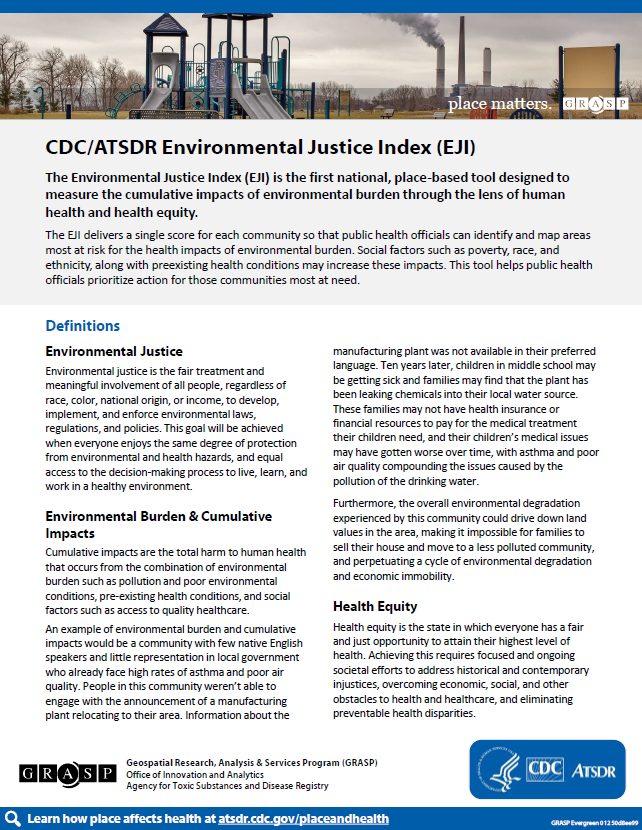EJI Fact Sheet
Overview
The Environmental Justice Index (EJI) is the first national, place-based tool designed to measure the cumulative impacts of environmental burden through the lens of human health and health equity.
The EJI delivers a single score for each community so that public health officials can identify and map areas most at risk for the health impacts of environmental burden. Social factors such as poverty, race, and ethnicity, along with preexisting health conditions may increase these impacts. This tool helps public health officials prioritize action for those communities most at need.
Definitions
Environmental justice
Environmental justice is the fair treatment and meaningful involvement of all people, regardless of race, color, national origin, or income, to develop, implement, and enforce environmental laws, regulations, and policies. This goal will be achieved when everyone enjoys the same degree of protection from environmental and health hazards, and equal access to the decision making process to live, learn, and work in a healthy environment.
Environmental burden and cumulative impacts
Cumulative impacts are the total harm to human health that occurs from the combination of environmental burden such as pollution and poor environmental conditions, pre-existing health conditions, and social factors such as access to quality healthcare.
An example of environmental burden and cumulative impacts would be a community with few native English speakers and little
representation in local government who already face high rates of asthma and poor air quality. People in this community weren’t able to engage with the announcement of a manufacturing plant relocating to their area. Information about the manufacturing plant was not available in their preferred language. Ten years later, children in middle school may be getting sick and families may find that the plant has been leaking chemicals into their local water source. These families may not have health insurance or financial resources to pay for the medical treatment their children need, and their children’s medical issues may have gotten worse over time, with asthma and poor air quality compounding the issues caused by the pollution of
the drinking water.
Furthermore, the overall environmental degradation experienced by this community could drive down land values in the area, making it impossible for families to sell their house and move to a less polluted community, and perpetuating a cycle of environmental degradation and economic immobility.
Health equity
Health equity is the state in which everyone has a fair and just opportunity to attain their highest level of health. Achieving this requires focused and ongoing societal efforts to address historical and contemporary injustices, overcoming economic,
social, and other obstacles to health and healthcare, and eliminating preventable health disparities.
Using the data
The EJI presents data for each census tract. Census tracts are the smallest subdivisions of land for which data are consistently available. Each census tract represents a county and is home to an average of 4,000 people.
The data used in the EJI comes from the U.S. Census Bureau, the U.S. Environmental Protection Agency, the U.S. Mine Safety and Health Administration, and the U.S. Centers for Disease Control and Prevention.
In addition to delivering a single environmental justice score for each community, the EJI also scores communities on each of the three modules in the tool (social vulnerability, environmental burden, health vulnerability) and allows more detailed analysis within these modules.
Individuals and community-based organizations, public health officials at local, state, and federal levels, scientists, and researchers to:
- identify and prioritize areas that may require special attention or additional action to improve health and health equity,
- educate and inform the public about their community,
- analyze the unique, local factors driving cumulative impacts on health to inform policy and decision-making, and
- establish meaningful goals and measure progress towards environmental justice and health equity.
Limitations of the EJI
The EJI is intended as a high-level mapping and screening tool that characterizes cumulative impacts and patterns of environmental injustice across the U.S. The tool relies on historical data generated by various institutions on varying time
scales.
The EJI is not intended as
- Definitive tool for labeling environmental justice communities,
- Tool for characterizing all environmental justice issues,
- Comprehensive representation of current or future social, environmental, or health characteristics,
- Representation of risk or exposure for a community, or
- Tool to tell whether individuals are at risk.
- Complete information on limitations of the EJI can be found in the data documentation.
Complete information on limitations of the EJI can be found in the technical documentation.

For more information, contact the EJI Coordinator at eji_coordinator@cdc.gov.
Media inquiries may be sent to placeandhealth@cdc.gov.